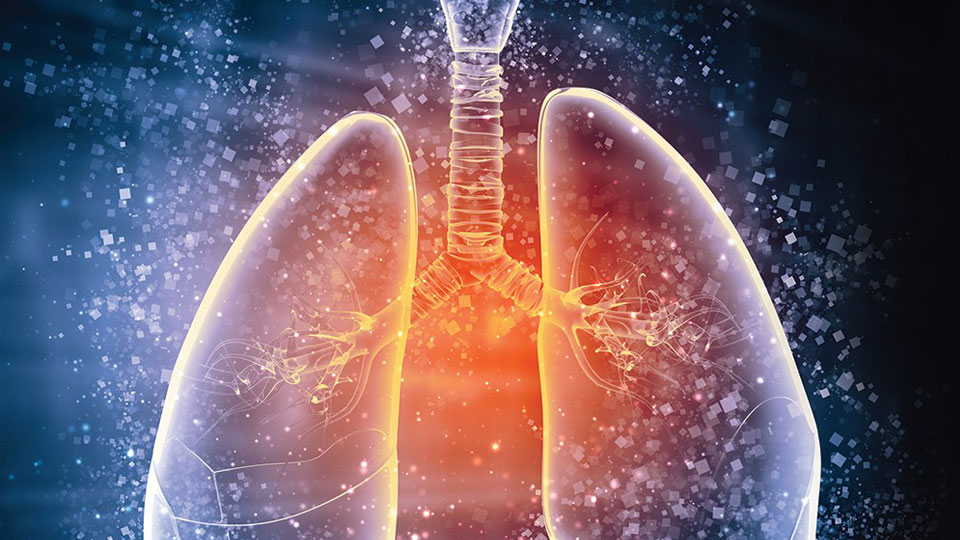What we know about COVID-19
SARS-CoV2, the virus responsible for the Coronavirus 2019 (COVID-19) outbreak, is brand new, so scientists are mobilising to understand it, while the world’s population remains immunologically immature to this virus. However, Queen’s researchers are learning lessons from years of studying similar lung diseases.
What makes COVID-19 so contagious? How and why is it killing people? These are just some of the big questions that the world is asking as lockdown and isolation efforts attempt to reduce the global spread of the disease. To try and better understand this new virus, Queen’s scientists are looking at what we can learn from similar diseases that affect the lungs.
Dr Ultan Power, Professor of Molecular Virology at the Wellcome-Wolfson Institute for Experimental Medicine, has been researching viruses that affect our respiratory system for over 30 years. His work involves working with lung models in the laboratory and studying how viruses interact with models of human tissues.
“My research tries to understand how respiratory viruses can cause disease in humans. We have developed tissue models that replicate part of the lung in our lab. It means we can infect these tissue models with our viruses in a safe, enclosed laboratory environment. We then try to ask questions and find solutions about how the virus interacts with those tissues,” explains Professor Power.
Where the virus targets
The primary focus for much of Professor Power’s research has been on the cells lining the lungs (lung epithelium), eyes, nose and mouth. “The reason we are interested in these cells is because they are the primary target of infection for virtually all respiratory viruses, including the one I work mostly with, which is Respiratory Syncytial Virus (RSV).”

These cells are also the primary target for SARS-CoV2 We know the virus is capable of infecting through the eyes, nose and through the mouth, but it’s what happens when it travels into the lower airways that is causing widespread health problems. “SARS-CoV2 will infect the lining of those cells, of the airways; referred to as ciliated epithelium cells. They will replicate there and progressively infect down along the respiratory tract and ultimately into the lower airways,” says Professor Power.
As a leading researcher on virus infections, Professor Power has seen the tremendous amount of damage that can be caused by the body’s response to a virus in the respiratory tract. He says:
“Normally with a virus infection, the virus will infect the airway epithelium cells, often the nose, replicate and descend to the lower respiratory tract. In doing so, it will cause the cells that it infects to send out thousands and thousands of small little protein molecules which alert the immune system that it is being invaded, being attacked. If those inflammatory responses are too severe, the consequences on the person will be severe also because the immune system will be in overdrive and cause a tremendous amount of damage to the lungs. This is exactly what happens with COVID-19 at the moment.”
The deadly immune “cytokine storm”
Throughout his research career, Professor Power has characterised this deadly immune response that can be caused as a result of flu infections. Known as a ‘cytokine storm’, this severe immune overreaction occurs due to an overproduction of immune cells and their activating compounds or proteins (cytokines). When someone becomes infected with the SARS-CoV2 virus, these cytokine storms have the potential to do significant damage to body tissues and organs.
“In the lower airways, SARS-CoV2 is capable of causing severe damage to the lungs,” says Professor Power. “The cells that are infected release these cytokines that cause this massive inflammatory response. Immune cells are attracted into the lungs to try and cope with infection. The result is pneumonia, severe damage to the lung tissues and can lead to the patient dying.”
Who gets infected and why?
While there are many similarities between the lung diseases that Professor Power has studied and COVID-19, there is one glaring difference: children seem to be less at risk. “We do not know why children seem to be more protected.,” says Professor Power. “Often, for viral diseases, it is the opposite, it’s the polar ends of the spectrum that are affected: that is very young children and very old people end up with serious respiratory viral infections that cause huge problems. The virus I work with most of the time, for example, RSV, that virus is the biggest single cause of lower respiratory lower tract infection in young infants, between six weeks of age and six months of age. It also causes a huge amount of mortality in the elderly. In the age group in between, we have repeat infections, but we don’t necessarily have the same level of disease.”
“What is peculiar about SARS-CoV2 and the COVID-19 outbreak, is that the vast majority of severe disease is only seen in the elderly and there seems to be much less serious disease in the young kids, even from the age of 20 down. We don’t know why. This is one of the things we need to understand: why does one part of the population, young people, seem okay and yet the elderly are having a very bad reaction and interaction with the virus?”
Professor Power adds, “The evidence so far indicates that the SARS-CoV2 has different clinical outcomes for different people. While the majority of people get extremely mild disease, significant numbers of elderly people are dying worldwide. There is a clear difference in how individuals from different ages cope with the infection and even within individual ages, there are different levels of severity of symptoms. Why those individuals become seriously ill with SARS-CoV2 and others don’t, we just don’t know yet. If we understand that, we might understand why the disease happens and be able to develop the best approaches to both prevent and treat this disease.”